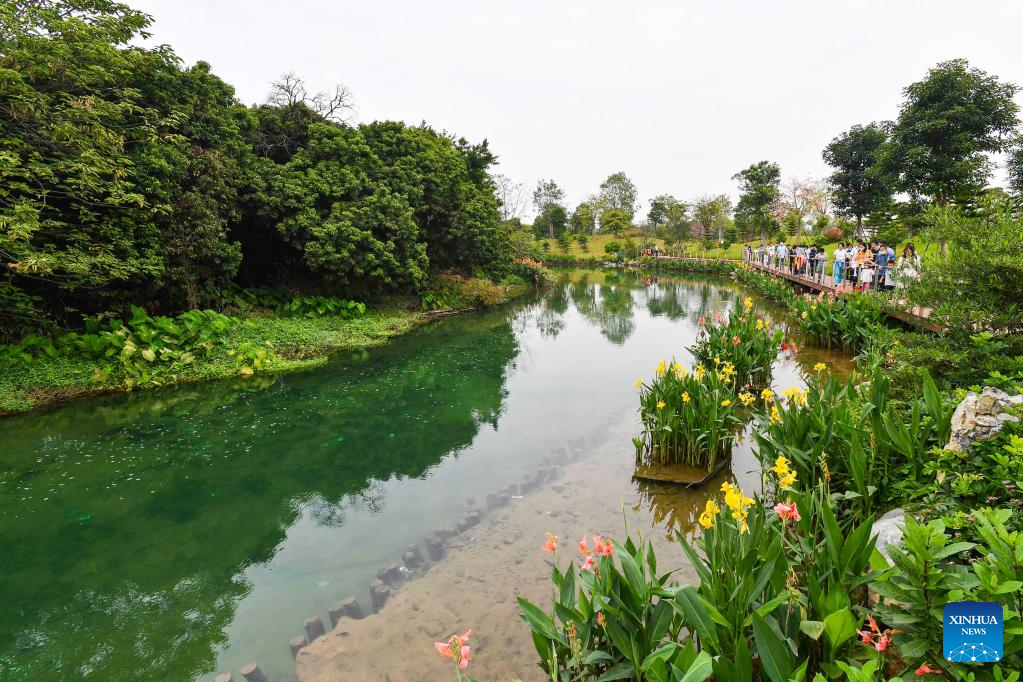Sewage treatment plants transformed into ecological underground sewage treatment plants in Guangzhou

Sewage treatment facilities were transferred to the underground with an average depth of 17 meters, and operate in a totally enclosed way, minimizing the impact of odor and noise. (Xinhua/Liu Dawei)
Reclaimed water pours out from Guangzhou Lijiao sewage treatment plant in Guangzhou, south China's Guangdong Province, Nov. 24, 2021. Traditional sewage treatment plants are being transformed into ecological underground sewage treatment plants in Guangzhou, to improve land utilization and tackle problems of secondary pollution.
With the first underground sewage treatment plant in Guangzhou was built in 2009, the city has built and upgraded 9 such plants so far, with a daily sewage treatment capacity of 1.81 million tonnes.

Sewage treatment facilities were transferred to the underground with an average depth of 17 meters, and operate in a totally enclosed way, minimizing the impact of odor and noise. (Xinhua/Liu Dawei)
People visit Guangzhou Lijiao sewage treatment plant in Guangzhou, south China's Guangdong Province, Nov. 21, 2021. Traditional sewage treatment plants are being transformed into ecological underground sewage treatment plants in Guangzhou, to improve land utilization and tackle problems of secondary pollution.
With the first underground sewage treatment plant in Guangzhou was built in 2009, the city has built and upgraded 9 such plants so far, with a daily sewage treatment capacity of 1.81 million tonnes.

Sewage treatment facilities were transferred to the underground with an average depth of 17 meters, and operate in a totally enclosed way, minimizing the impact of odor and noise. (Xinhua/Liu Dawei)
Geese swim in a pond at Guangzhou Shijing sewage treatment plant in Guangzhou, south China's Guangdong Province, Nov. 19, 2021. Traditional sewage treatment plants are being transformed into ecological underground sewage treatment plants in Guangzhou, to improve land utilization and tackle problems of secondary pollution.
With the first underground sewage treatment plant in Guangzhou was built in 2009, the city has built and upgraded 9 such plants so far, with a daily sewage treatment capacity of 1.81 million tonnes.

Sewage treatment facilities were transferred to the underground with an average depth of 17 meters, and operate in a totally enclosed way, minimizing the impact of odor and noise. (Xinhua/Liu Dawei)
People watch a video at the intelligent operation center of Guangzhou Lijiao sewage treatment plant in Guangzhou, south China's Guangdong Province, Nov. 21, 2021. Traditional sewage treatment plants are being transformed into ecological underground sewage treatment plants in Guangzhou, to improve land utilization and tackle problems of secondary pollution.
With the first underground sewage treatment plant in Guangzhou was built in 2009, the city has built and upgraded 9 such plants so far, with a daily sewage treatment capacity of 1.81 million tonnes.

Sewage treatment facilities were transferred to the underground with an average depth of 17 meters, and operate in a totally enclosed way, minimizing the impact of odor and noise. (Xinhua/Liu Dawei)
Photo taken on Nov. 24, 2021 shows Guangzhou Lijiao sewage treatment plant and a wetland in Guangzhou, south China's Guangdong Province. Traditional sewage treatment plants are being transformed into ecological underground sewage treatment plants in Guangzhou, to improve land utilization and tackle problems of secondary pollution.
With the first underground sewage treatment plant in Guangzhou was built in 2009, the city has built and upgraded 9 such plants so far, with a daily sewage treatment capacity of 1.81 million tonnes.

Sewage treatment facilities were transferred to the underground with an average depth of 17 meters, and operate in a totally enclosed way, minimizing the impact of odor and noise. (Xinhua/Liu Dawei)
Technicians work at Guangzhou Xilang sewage treatment plant in Guangzhou, south China's Guangdong Province, Dec. 21, 2021. Traditional sewage treatment plants are being transformed into ecological underground sewage treatment plants in Guangzhou, to improve land utilization and tackle problems of secondary pollution.
With the first underground sewage treatment plant in Guangzhou was built in 2009, the city has built and upgraded 9 such plants so far, with a daily sewage treatment capacity of 1.81 million tonnes.

Sewage treatment facilities were transferred to the underground with an average depth of 17 meters, and operate in a totally enclosed way, minimizing the impact of odor and noise. (Xinhua/Liu Dawei)
Panoramic photo taken by cell photo shows the water outlet of Guangzhou Lijiao sewage treatment plant in Guangzhou, south China's Guangdong Province, Nov. 24, 2021. Traditional sewage treatment plants are being transformed into ecological underground sewage treatment plants in Guangzhou, to improve land utilization and tackle problems of secondary pollution.
With the first underground sewage treatment plant in Guangzhou was built in 2009, the city has built and upgraded 9 such plants so far, with a daily sewage treatment capacity of 1.81 million tonnes.
Photos
Related Stories
Copyright © 2021 People's Daily Online. All Rights Reserved.










